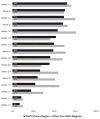An overview of tobacco control and prevention policy status in Africa
- PMID: 26876626
- PMCID: PMC5556684
- DOI: 10.1016/j.ypmed.2016.02.017
An overview of tobacco control and prevention policy status in Africa
Abstract
Tobacco smoking prevalence remains low in many African countries. However, growing economies and the increased presence of multinational tobacco companies in the African Region have the potential to contribute to increasing tobacco use rates in the future. This paper used data from the 2014 Global Progress Report on implementation of the World Health Organization Framework Convention on Tobacco Control (WHO FCTC), as well as the 2015 WHO report on the global tobacco epidemic, to describe the status of tobacco control and prevention efforts in countries in the WHO African Region relative to the provisions of the WHO FCTC and MPOWER package. Among the 23 countries in the African Region analyzed, there are large variations in the overall WHO FCTC implementation rates, ranging from 9% in Sierra Leone to 78% in Kenya. The analysis of MPOWER implementation status indicates that opportunities exist for the African countries to enhance compliance with WHO recommended best practices for monitoring tobacco use, protecting people from tobacco smoke, offering help to quit tobacco use, warning about the dangers of tobacco, enforcing bans on tobacco advertising and promotion, and raising taxes on tobacco products. If tobacco control interventions are successfully implemented, African nations could avert a tobacco-related epidemic, including premature death, disability, and the associated economic, development, and societal costs.
Keywords: MPOWER; Tobacco control and prevention policy status in Africa; WHO African Region; WHO FCTC Articles; WHO FCTC and MPOWER implementation status; WHO Framework Convention on Tobacco Control.
Published by Elsevier Inc.
Conflict of interest statement
The authors declare that there is no conflict of interest.
Figures

References
-
- Bilano V, Gilmour S, Moffi T, et al. Global trends and projections for tobacco use, 1990–2025: An analysis of smoking indicators from the WHO Comprehensive Information Systems for Tobacco Control. [Last accessed on November 09, 2015];Lancet. 2015 2015(385):966–976. http://dx.doi.org/10.1016/S0140-6736(15)60264-1 http://www.thelancet.com/journals/lancet/article/PIIS0140-6736(15)60264-.... - DOI - PubMed
-
- Blecher E, Ross H. Tobacco use in Africa: tobacco control through prevention. [Last accesses on November 09, 2015];Am Cancer Soc. 2013 http://www.cancer.org/acs/groups/content/@internationalaffairs/documents....
-
- Chaloupka FJ, Yurekli A, Fong GT. Reviews: tobacco taxes as a tobacco control strategy. [Last accessed on November 09, 2015];Tob Control. 2012 (21):172–180. http://dx.doi.org/10.1136/tobaccocontrol-2011-050417http://tobaccocontro.... - DOI - PubMed
-
- Doku D. The tobacco industry tactics – a challenge for tobacco control in low and middle income countries. [Accessed on November 09, 2015];Afr Health Sci. 2010 10(2):201–203. http://www.ncbi.nlm.nih.gov/pmc/articles/PMC2956281/ - PMC - PubMed
-
- Drope J. Tobacco Control in Africa: People, Politics and Policies. Anthem Press; New York, NY: 2011. [Accessed on November 09, 2015]. http://www.idl-bnc.idrc.ca/dspace/bitstream/10625/47373/1/IDL-47373.pdf.
Publication types
MeSH terms
Substances
Grants and funding
LinkOut - more resources
Full Text Sources
Other Literature Sources
Medical

